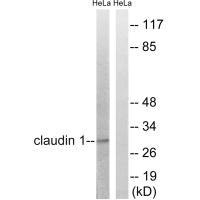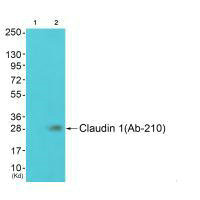
Western blot analysis of extracts from HeLa cells, treated with Hu (2nM, 24hours), using Claudin 1 (Ab-210) antibody.
CLDN1 (Ab-210) Antibody
CSB-PA133727
ApplicationsWestern Blot, ELISA
Product group Antibodies
ReactivityHuman, Mouse
TargetCLDN1
Overview
- SupplierCusabio
- Product NameCLDN1 (Ab-210) Antibody
- Delivery Days Customer20
- ApplicationsWestern Blot, ELISA
- CertificationResearch Use Only
- ClonalityPolyclonal
- ConjugateUnconjugated
- Gene ID9076
- Target nameCLDN1
- Target descriptionclaudin 1
- Target synonymsclaudin-1; CLD1; ILVASC; SEMP1; senescence-associated epithelial membrane protein 1
- HostRabbit
- IsotypeIgG
- Protein IDO95832
- Protein NameClaudin-1
- Scientific DescriptionClaudins function as major constituents of the tight junction complexes that regulate the permeability of epithelia. While some claudin family members play essential roles in the formation of impermeable barriers, others mediate the permeability to ions and small molecules. Often, several claudin family members are coexpressed and interact with each other, and this determines the overall permeability. CLDN1 is required to prevent the paracellular diffusion of small molecules through tight junctions in the epidermis and is required for the normal barrier function of the skin. Required for normal water homeostasis and to prevent excessive water loss through the skin, probably via an indirect effect on the expression levels of other proteins, since CLDN1 itself seems to be dispensable for water barrier formation in keratinocyte tight junctions (). CLDN1 acts as a coreceptor for HCV entry into hepatic cells. Swisshelm K.L., Gene 226:285-295(1999). Halford S., Cytogenet. Cell Genet. 88:217-217(2000). Kraemer F., Hum. Genet. 107:249-256(2000).
- ReactivityHuman, Mouse
- Storage Instruction-20°C or -80°C
- UNSPSC12352203

